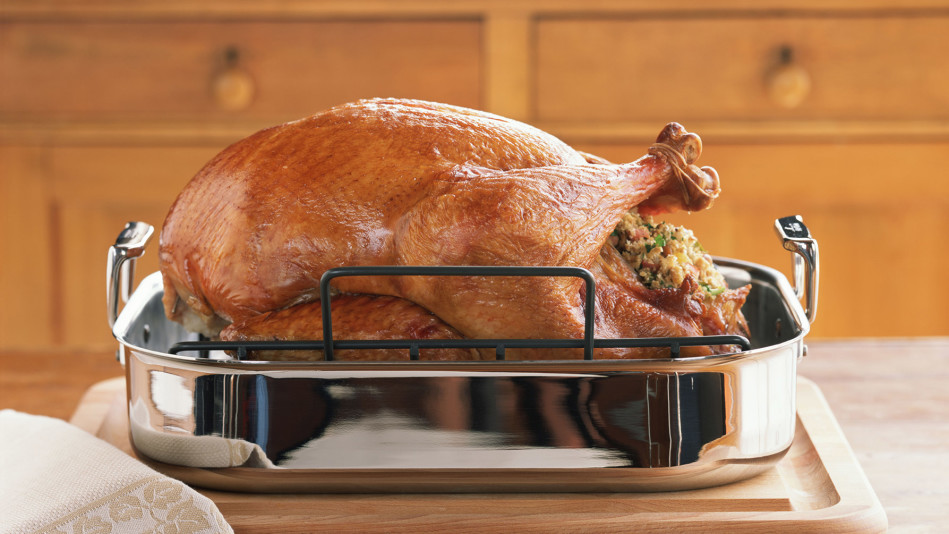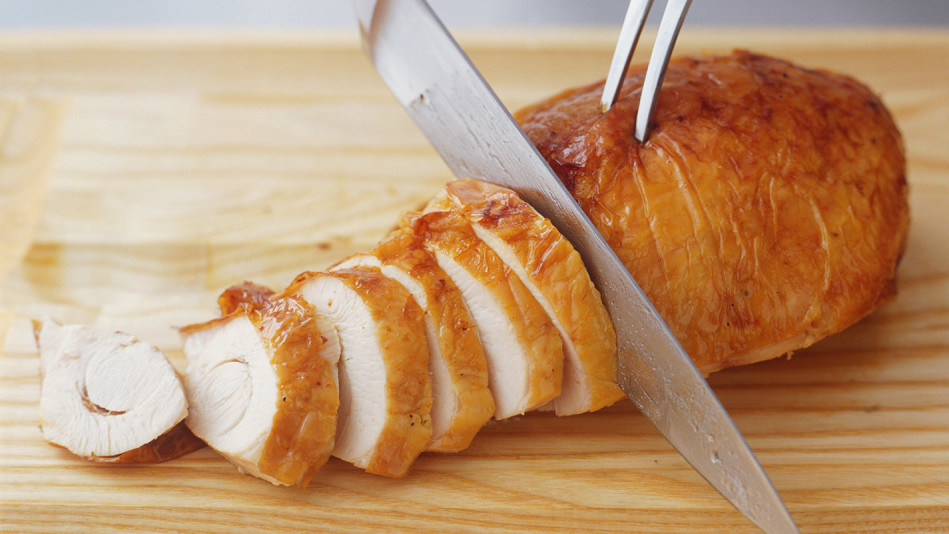The Brilliant Trick for Perfectly Carving a Turkey
It's not rocket science. It's anatomy, actually. And it's way easier than you think.

Photo: Brian Leatart/Getty Images
If every year on the fourth Thursday in November you find yourself cooking the turkey, but ceding the carving of it to someone else in the family, it's time to take control. Cutting the bird into presentable portions is surprisingly simple, especially when you've just spent hours seasoning, monitoring and basting it. Plus, it's one of the most empowering culinary maneuvers we know of.
We talked to a group of experts with about 65 years of turkey-carving experience among them, and they all agreed that the first thing to remember when wielding the knife is to not do it at the table. If you're nervous, the last thing you need is an audience. Furthermore, says Mark Gaier, who, with Clark Frasier, has been serving Thanksgiving dinner to guests for years at their restaurants M.C. Spiedo, in Boston, and MC Perkins Cove, in Ogunquit, Maine, you need a big cutting board (one with a trough to catch the juices is ideal) and plenty of elbow room to get the meat off the bones. A dining room table crammed with side dishes isn't going to give you enough space. Have a nice, big platter nearby, and arrange the cut turkey on it; then carry it to the table and bask in the applause.
As for the actual carving, you'll want an 8- to 9-inch carving knife that's been recently sharpened, along with a two-pronged fork to help steady the turkey as you cut (with a sharp knife you'll be able to cut, not saw). Begin with the turkey breast-side up, and remove the legs first, by inserting the fork into one thigh and separating it (along with the drumstick; you can keep them together for now) using the knife. Use the tip of the knife to free the ball joint that connects the leg to the rest of the bird. Take off the other leg and reserve both for later.
Next: the trick that'll make everything worlds easier.
We talked to a group of experts with about 65 years of turkey-carving experience among them, and they all agreed that the first thing to remember when wielding the knife is to not do it at the table. If you're nervous, the last thing you need is an audience. Furthermore, says Mark Gaier, who, with Clark Frasier, has been serving Thanksgiving dinner to guests for years at their restaurants M.C. Spiedo, in Boston, and MC Perkins Cove, in Ogunquit, Maine, you need a big cutting board (one with a trough to catch the juices is ideal) and plenty of elbow room to get the meat off the bones. A dining room table crammed with side dishes isn't going to give you enough space. Have a nice, big platter nearby, and arrange the cut turkey on it; then carry it to the table and bask in the applause.
As for the actual carving, you'll want an 8- to 9-inch carving knife that's been recently sharpened, along with a two-pronged fork to help steady the turkey as you cut (with a sharp knife you'll be able to cut, not saw). Begin with the turkey breast-side up, and remove the legs first, by inserting the fork into one thigh and separating it (along with the drumstick; you can keep them together for now) using the knife. Use the tip of the knife to free the ball joint that connects the leg to the rest of the bird. Take off the other leg and reserve both for later.
Next: the trick that'll make everything worlds easier.

Photo: Dorling Kindersley/Getty Images
Here's the thing you need to remember: Don't carve the breast meat right off the whole bird. Remove each breast, then slice it. It may seem obvious, but Alex Jermasek, the head butcher at Belcampo Meat Co., a farm, butcher shop and restaurant with multiple California locations, says you'd be surprised how many people just attack the turkey with their knife, sawing away at the breast. They wind up hacking the meat into shreds—and cutting this way actually makes the meat less tasty.
Instead, locate the keel bone (also called the breast bone; it's an extension of the sternum) and use your knife to score the meat, tracing along both edges of the bone. You should then be able to peel both breasts away, using your hands. You'll have two torpedo-shaped pieces of white meat; Jermasek likes to start at each torpedo's wider end, and make the slices rather thick, going crosswise (this is the key to making the breast as delicious-tasting as possible, since cutting against the grain gives you more tender meat), about a half- to three-quarters of an inch thick. That may be thicker than you're used to, but Jermasek promises a steak-like piece of breast meat is going to be much tastier than a thin slice that's shaved off lengthwise. Depending on the size of the turkey, you'll get anywhere from six to 10 slices from each breast.
Now, back to the dark meat. The wings are probably best for flavoring gravy or stock, says Gaier. Separate the drumsticks from the thighs and keep the drumsticks whole (first, they're probably the most recognizable, impressive-looking pieces of the entire bird; and second, they contain a lot of pin bones, which can make them hard to cut neatly). As for the thighs, Jermasek has a genius tip: Shred them into large-ish chunks using forks, then toss them with a bit of gravy to season them. Present the sliced breast meat with the drumsticks at one end of the platter, and arrange the shredded, gravy-soaked thigh meat around the edges.
One last piece of advice from Gaier: Practice on a chicken. The anatomy is virtually the same, and if you carve a roast chicken the week before Thanksgiving, you'll be more sure of yourself on the big day.
Instead, locate the keel bone (also called the breast bone; it's an extension of the sternum) and use your knife to score the meat, tracing along both edges of the bone. You should then be able to peel both breasts away, using your hands. You'll have two torpedo-shaped pieces of white meat; Jermasek likes to start at each torpedo's wider end, and make the slices rather thick, going crosswise (this is the key to making the breast as delicious-tasting as possible, since cutting against the grain gives you more tender meat), about a half- to three-quarters of an inch thick. That may be thicker than you're used to, but Jermasek promises a steak-like piece of breast meat is going to be much tastier than a thin slice that's shaved off lengthwise. Depending on the size of the turkey, you'll get anywhere from six to 10 slices from each breast.
Now, back to the dark meat. The wings are probably best for flavoring gravy or stock, says Gaier. Separate the drumsticks from the thighs and keep the drumsticks whole (first, they're probably the most recognizable, impressive-looking pieces of the entire bird; and second, they contain a lot of pin bones, which can make them hard to cut neatly). As for the thighs, Jermasek has a genius tip: Shred them into large-ish chunks using forks, then toss them with a bit of gravy to season them. Present the sliced breast meat with the drumsticks at one end of the platter, and arrange the shredded, gravy-soaked thigh meat around the edges.
One last piece of advice from Gaier: Practice on a chicken. The anatomy is virtually the same, and if you carve a roast chicken the week before Thanksgiving, you'll be more sure of yourself on the big day.



